What is a vvg cable: decryption, characteristics + subtleties of cable selection
Building a home electrical network is available to anyone who has mastered the school physics course. Agree, electrician services will cost a lot, and independent experience will always be useful.
But amateur masters usually face the problem of choosing a cable. What type of wiring is the most reliable and safe? The answer is simple - a standard VVG cable designed for assembling AC circuits.
If you decide to do home electrical wiring yourself, we suggest that you familiarize yourself with useful information. We will analyze what a VVG cable is: decoding alphabetic symbols and a review of characteristics will help you choose the best modification.
The content of the article:
Purpose and application features
The VVG cable is designed for transmission and distribution of electricity in stationary installations with a frequency of 50 Hz and an operating voltage of 660 to 1000 V.
It is used for installation, repair or full wiring replacement in residential and industrial buildings. Reinforced species are suitable for installation in fire hazardous, wet, underground rooms.
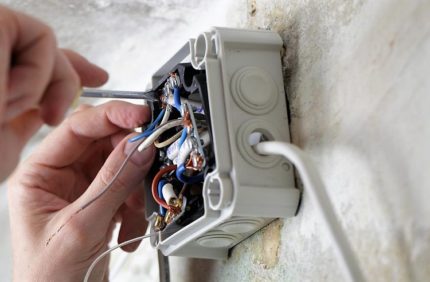
In addition to popular species, designed for a frequency of 50 Hz, there are modifications for use at 100 Hz. If necessary, you can choose wires for a 1-phase or 3-phase circuit, for installation inside and outside buildings.
If the wire is pulled outside the house, he needs additional protection - a metal sleeve, durable cable channel, special tray or corrugated pipe.
For wiring in the ground, mine, collector protection should be maximum, as the product is completely no reservation. Especially for difficult installation conditions, there is another option - the armored cable VBBSHV.
Wiring device in wooden house also requires protection in the form of a metal hose, non-combustible channel or metal pipe.
Decoding of letters and types of VVG
The type of cable is easy to determine even if it is packaged in a bay: appropriate marking is applied to the surface of the outer insulation. Among the many alphanumeric characters and type of cable. What do these common letter combinations mean?
VVG - a copper cable, each core of which is protected by a sheath of polyvinyl chloride, and the outer insulation is also made of PVC. "G" - the absence of armor or other durable shell for use in aggressive conditions.
Literally, it stands for:
- “B” - vinyl;
- “B” - vinyl;
- “G” is naked.
Both veins and sheaths are made of various materials having special technical characteristics. Based on this, various types of VVG cable are isolated.
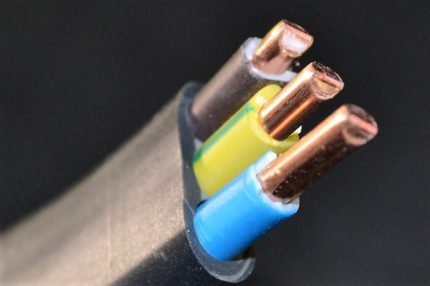
Accordingly, copper products are ideal for home use.
The most popular types of power wires.
VVGng - non-combustible / low flammability. Resistance to fire is explained by the addition of non-combustible ingredients to the plastic. If a fire occurs, the wiring will not burn itself and will not ignite from adjacent cables.
VVGng LS - type of non-combustible cable with low gas and smoke emission. LS is Low Smoke.
VVGng LSLTx - LTx - Low Toxic (low toxicity) is added to the above qualities. When ignited, no hazardous substances are released from the enclosure. The most protected cable of this type is in demand in preschool and educational institutions, clinics and hospitals.
VVGng HF - halogen substances such as chlorine and other HF - Halogen Free (without halogens) are not present in the shell.
VVGng FRLS - cable for group mounting, its feature is maximum resistance to fire. FRLS - Fire Resistance. Even for 3 hours, the cable will not catch fire and smoke due to the mica.
VVG-Png - flat wire with 2-3 cores, non-combustible. Sometimes it is more convenient to connect a flat cable to other wires or place it in plinths, boxes.

For the device of home electrical circuits, you do not need to purchase expensive species with additional protection.
Usually they use a budgetary VVG cable, which is most suitable for internal work, or VVGng, if group installation is planned.
Number and shape of conductors
All cables can be divided into two categories - single-core and multi-core.
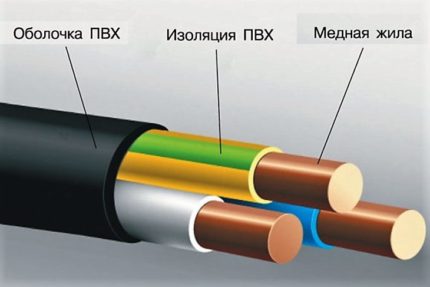
The number of conductors under the outer sheath of the cable is from 2 to 6, while the cross-section of the cores can be any - from 1.5 to 250 mm².
For home electrical networks, products with zero and ground wires are more often used. The insulation of the first is blue, the second is yellow-green.
In the market, in addition to round, there is also a segmented shape of conductors. It is advisable to use it in the manufacture of large-diameter cables for compactness, so that there are no voids between the individual cores.
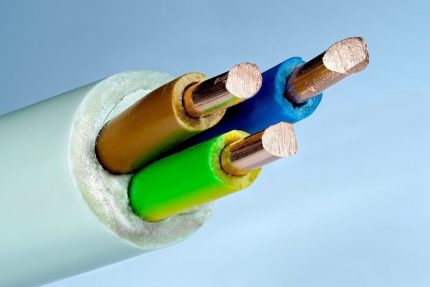
In VVG products of small diameter - up to 25 mm - internal filling may not be used.
VVG cable specifications
In order to correctly determine the purpose of the wire, it is necessary to clarify its technical and operational characteristics, which relate to design features, dimensions and weight, physical indicators. Consider the main selection criteria.
# 1 - design features
Considering many modifications, one should choose the most successful one from all the options on the market. And for this you need to compare the characteristics of different products.
Suppose the choice is between VVG and VVGng - which one is best for kitchen wiring? Both copper, three-core, "sealed" in a PVC sheath. In appearance, the difference is impossible to find.
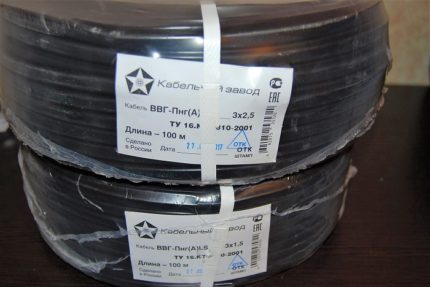
Given that the kitchen is usually crammed with electrical household appliances, it is better to play it safe and choose the option with a non-combustible braid. Although for single wires with a small load, a standard 3-wire VVG cable of 2-2.5 mm is suitable, but for group installation it is better to take the product in non-combustible insulation.
Can I use other types of wires, for example, VVGng LS? Yes, but this is not always advisable. Cables with reduced smoke emission are more complicated in design: they are multicore, consist of twisted round or segment conductors, filled with plastic, one wire can be of smaller cross-section.
The LS version is usually used in industrial plants or in other rooms where there is a real risk of accidental fire.
# 2 - cross section
For household use, a cable with a cross section of each core from 1.5 to 3.5 mm² is used, for industrial - up to 250 mm². Products with a small cross section are always on sale, modifications with parameters above 35 mm² are usually brought to order.
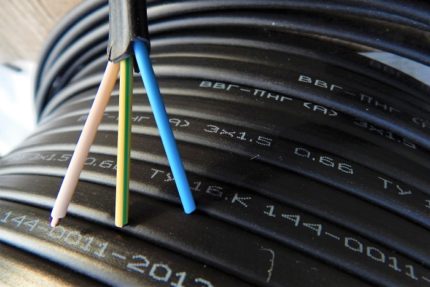
If you are offered a cable in which one conductor is smaller in diameter, then it is fearless. Most likely, this is a grounding conductor, which usually consists of a yellow-green shell.
Whether there is a smaller core inside the outer shell than the others, can also be identified by marking. Usually, a digital designation “+1” is attributed to the name. Example of the name: VVGng 3x2.5 mm² + 1 - that is, 3 cores with a cross section of 2.5 mm² plus one step one smaller, 1.5 mm².
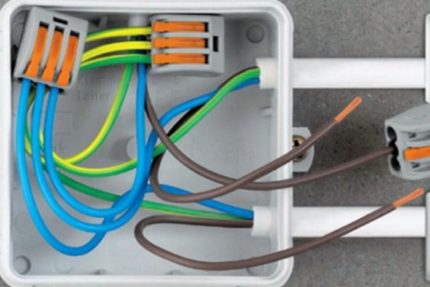
Both “single-gauge” products and wires with unequal cross-sectional conductors are classified as standard and are manufactured according to GOST.
# 3 - parameters of continuous permissible current
When choosing a cross-section, the main role is played not so much by the resistance of the conductors as by the magnitude of the electric current, the maximum permissible in the circuit.
It depends on the following factors:
- installation method;
- number of cores;
- section of each core.
The installation method means open or closed (in the gates) installation.

We remind you that VVG wires are used for AC wiring from 0.66 to 1 kW.
# 4 - weight of VVG cable
The cable is sold by manufacturers and intermediaries, which are stores of building and electrical materials and specialized companies. Various modifications with a cross section of 1.5-2.5 mm² are sold in bays and segments from 10 to 100 m.
It is clear that the weight will directly depend on both the section and the footage. It is estimated that the mass of the VVGng bay wire 1 km long, depending on the cross-section, can weigh 30, 10, and 250 kg.
A 100-meter bay of a 3-core VVG cable with a cross section of 2.5 mm² weighs a little more than 13.5 kg.
# 5 - other operational and physical indicators
When buying a bay or a piece of cable, you can ask about the other technical characteristics, which are necessarily indicated in the accompanying documentation.
The following values are characteristic of the VVG cable:
- working temperature - -50 ° С - +50 ° С; max temperature - up to +70 ° С (with prolonged use); emergency temperature - +80 ° С (during short-term overheating);
- the minimum temperature value for installation is -15 ° C or higher;
- relative air humidity - 98% (at t +35 ° С);
- climatic modification - T / UHL (tropical or moderately cold climate, respectively);
- service life - 30 years, warranty - up to 5 years;
- bending radius - not less than 7.5 outer diameters for multicore products, 10 outer diameters - for single-core.
The bays should be stored indoors for a maximum of 10 years, in the open air (under a canopy) - no more than 5 years. The absence of a canopy reduces the shelf life to 2 years.

Recommendations for using VVGng in everyday life:
- lighting contours - 3x1.5;
- rosette groups - 3x2.5;
- connection of powerful equipment (boiler, stove, dishwasher) - 3x4.
The last version of the cable can withstand loads up to 8 kW - this is enough to build the most energy-intensive kitchen network.
Conclusions and useful video on the topic
About cable marking:
What type of cable is best for outlets and why:
About the choice of cable section:
The best option for use in residential buildings - VVGng copper cable. Inexpensive, convenient to use and assemble electrical networks, suitable for connecting electromechanical installations and household appliances.
When choosing a cross-section, be sure to consider the approximate load, if in doubt about the correct conclusions - consult with sellers or qualified electricians.
Remember: the life of your family and the safety of property depend on reliable and safe material for wiring!
We introduced you only with general information about the VVG cable, without touching on the technical subtleties of production, installation and connection methods. If you have experienced electricians among you, please comment on controversial issues, share your own experience or valuable advice. Photo illustrations will be the best complement to your story.

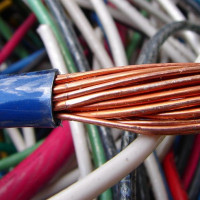 Types of cables and wires and their purpose: description and classification + decoding of marking
Types of cables and wires and their purpose: description and classification + decoding of marking  What cable to do wiring in a wooden house: types of non-combustible cable and its safe installation
What cable to do wiring in a wooden house: types of non-combustible cable and its safe installation  RJ45 twisted pair cable pinout: wiring diagrams and crimping rules
RJ45 twisted pair cable pinout: wiring diagrams and crimping rules  Wire stripping tool: all about cable strippers
Wire stripping tool: all about cable strippers 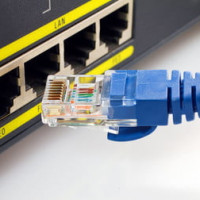 How to crimp an RJ-45 Internet cable with your own hands: ways + instructions for crimping an Internet connector
How to crimp an RJ-45 Internet cable with your own hands: ways + instructions for crimping an Internet connector  Connecting a heating cable: detailed installation instructions for a self-regulating heating system
Connecting a heating cable: detailed installation instructions for a self-regulating heating system  How much does it cost to connect gas to a private house: the price of organizing gas supply
How much does it cost to connect gas to a private house: the price of organizing gas supply  The best washing machines with dryer: model rating and customer tips
The best washing machines with dryer: model rating and customer tips  What is the color temperature of light and the nuances of choosing the temperature of the lamps to suit your needs
What is the color temperature of light and the nuances of choosing the temperature of the lamps to suit your needs  Replacement of a geyser in an apartment: replacement paperwork + basic norms and requirements
Replacement of a geyser in an apartment: replacement paperwork + basic norms and requirements